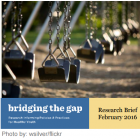Equity is a central component of our work at the Safe Routes Partnership. Who gets to move?, Where?, When?, and How? are questions about power and access. Who makes these decisions and for whom? Historical legacies and sustained realities of structural discrimination (based on race, class, gender, sexuality, immigration status, etc.) have created inequality of roles and participation in transportation planning decisions, which has, in turn, disparately impacted transportation options and access for different populations. Because transportation facilitates access to opportunities (educational, social, recreational, professional, etc.) and participation in the public sphere, limited transportation opportunities compound existing disparities in education, employment, political engagement, health, and safety.
Within the field of transportation research, equity has largely been omitted from academic scholarship and insufficiently applied in practice (Lee et al., 2017). Fortunately, equity is increasingly gaining traction among policymakers and practitioners in the transportation world especially as more people realize that a greater modal shift to active, sustainable transportation simply cannot occur without an equity perspective (McAndrews et al., 2017; McNeil et al., 2017; Lusk et al., 2017).
This section highlights research that demonstrates the need for and value of an equity perspective in Safe Routes to School and active transportation overall. We’ve pulled out available research in this Equity category to make it easily accessible and encourage further research into the equity implications. These research summaries are cross-posted in relevant research sections, since equity is not an add-on, but a core component of Safe Routes to School and active transportation.
Research Highlights:
- Low-income Americans currently walk and bike more than Americans with higher incomes, and the fastest growth in biking is occurring among people of color (McKenzie, 2014 and League of American Bicyclists 2013). However, sidewalks exist in only 49% of low-income communities, compared to 90% in high-income communities (Gibbs, et a.l, 2012).
- There are harmful, and even fatal consequences of insufficient infrastructure for safe walking and biking:
- Children from families with low income, who are twice as likely to walk to school, disproportionately face more traffic and personal safety challenges while en route to/from school (McDonald, 2008).
- Black and Latino people are twice as likely to be killed while walking (Maciag, 2014).
- Black people are 30% more likely to be killed biking, and Latino people are 23% more likely to be killed biking (League of American Bicyclists, 2013).
- Fear is a big barrier to bicycling for Blacks and Hispanics. While most people are afraid of traffic danger while bicycling, Black and Hispanic communities are disproportionately worried about being victims of crime (i.e., robbery and assault) while biking, as well as racial profiling and police harassment. Transportation professionals must consider how broader structural inequalities like racism can hinder active modes of transportation for people of color (Brown, 2016).
- While most bike share users tend to be white and middle-class, there is high interest and demand for bike share from underrepresented groups, such as people of color and people with low income). A majority of people with low income would like to use bike share more and low-income people of color are more inclined to try bike share for exercise, recreational, and social reasons (McNeil et al., 2017).
- Black women have higher risks of nonfatal injury than women of other racial groups when traveling by foot or by car. More alarmingly, black women are the only demographic group with a higher risk of fatal injury as pedestrians than as motor vehicle occupants (McAndrews et al., 2017).
- A ground-breaking study of near misses in the United Kingdom has revealed that bicycling speed is the main factor affecting near miss rates (incidents that don’t result in injuries but still are scary, annoying, and/or stressful). Women, who tend to bike more slowly than men do, experience higher rates of near misses than men, which can factor into and perpetuate the gender gap in bicycling. This underscores the importance of quality, safe bicycling infrastructure, particularly for more vulnerable groups (Aldred, 2016).
- There are racial differences in bicycle infrastructure preferences and bicycling practices planners and engineers must keep in mind to increase equity in bicycling. For example, compared with white people, more Black and Hispanic people would bike more if they could bike with family and friends. This suggests that creating wider bike lanes that enable people to ride alongside each other, rather than in single file, may help increase cycling among people of color (Lusk et al., 2017).


